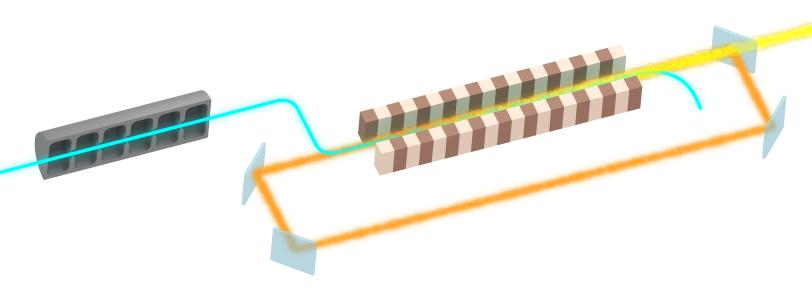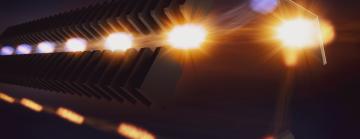Researchers show how to increase X-ray laser brightness and power using a crystal cavity and diamond mirrors
The long – but not too long – cavity would ping-pong X-ray pulses inside of a particle accelerator facility to help capture nature’s fastest movements.
By David Krause
At particle accelerator facilities around the world, scientists rely on powerful X-rays to reveal the structure and behavior of atoms and molecules. Now, researchers from the Department of Energy’s SLAC National Accelerator Laboratory have calculated how to make X-ray pulses at X-ray free-electron lasers (XFEL) even brighter and more reliable by building a special cavity chamber and diamond mirrors around an XFEL.
“We want to make our XFELs more laser-like,” said Zhirong Huang, a SLAC and Stanford professor of photon science. “We’ve been searching for a way to do this for decades, and with our new calculations, we demonstrate that this pipedream could become reality.”
At XFELs like SLAC’s Linac Coherent Light Source (LCLS), the power of individual X-ray pulses varies from pulse to pulse. The result is temporally incoherent light rays – less laser-like lasers – which are more difficult for scientists to use to complete experiments because they are less predictable.
In a new study, detailed this month in Physical Review Letters, researchers show how to generate coherent X-ray pulses using an intricate crystal cavity and mirror system – and without needing a cavity that is extraordinarily long and complicated.
“The motivation for generating coherent, higher brightness X-rays is to study real-world materials and what happens to those materials under different conditions,” SLAC scientist and paper co-author Jingyi Tang said. “We want to study systems that are more dynamic and difficult to capture.”
Storing light using mirrors
The idea of catching X-rays using mirrors might seem impossible at first thought. But at a high-repetition-rate accelerator like LCLS-II, such an idea could be possible – if you have the right storage equipment and a good imagination.

The researchers studied what’s called a cavity-based X-ray Free electron laser (CBXFEL). In this design, a cavity structure – maybe hundreds of meters or even more than a kilometer long – captures incoherent X-ray pulses that have been generated at an accelerator facility, like the one at SLAC.
Inside the cavity, X-rays bounce off of four diamond mirrors, which send the X-ray pulses in rectangular laps. While the pulses run around inside of the cavity, the next electron bunch inside of the accelerator travels toward them. When the bunch arrives, the bouncing X-ray pulse interacts with the electron bunch, tightening it up and organizing it. When wiggled about in a device called an undulator, this tighter electron bunch will produce more coherent and brighter X-rays farther down the accelerator.
Prior to their new calculations, researchers thought that maintaining an X-ray pulse’s power as it bounced around the cavity could require closely spaced electron bunches or a kilometers long cavity, making the idea much harder to implement.
“We showed that a high-quality cavity system might only need to be 100-300 meters long, even with a powerful XFEL operating at slower repetition rate, which means more space between electrons bunches,” SLAC scientist and co-author Zhen Zhang said.
Controlling the cavity loss
The key to this new design is controlling what researchers call the quality factor of the cavity, Q. The quality factor represents the reflectivity of the mirrors in the cavity. A high Q value means very high reflectivity, which allows the X-ray power to recirculate in the cavity with little loss. A lower Q value means lower reflectivity, meaning significant amount of X-rays leave the cavity and are transmitted down the accelerator.
When the X-rays are recirculated in a shorter cavity without any interaction with the electron bunch, Q is kept very high. When these X-rays interact with an incoming electron bunch, researchers can precisely control the amplified X-ray wavelength and spectrum to change the cavity Q – called Q-switching. This means that they can lower the Q value when the X-rays have high enough power – i.e., when the X-rays are ready to leave the cavity and travel down the accelerator to experiments.
By controlling Q, researchers can give the coherent X-ray pulse their turn to recirculate multiple times around the cavity and mirror system. This ability for the coherent X-ray pulses to now travel around the system with little loss gives the pulses more time to build up power, thus shortening the needed cavity length and creating X-rays with high output power.
In the coming year, scientists and engineers at SLAC, in collaboration with Argonne National Laboratory and other institutions, are working on building a test cavity at SLAC’s LCLS. The initial goals of the experiment are to demonstrate the power increase after the X-ray is recirculated by the cavity and to observe the cavity’s performance. Q-switching could also be tested on such a CBXFEL system after the initial goals of the experiment are reached, researchers said.
This project was supported in part by the DOE’s Office of Science.
Citation: Tang, Zhang et al., Physical Review Letters, 31 July 2023 (doi.org/10.1103/PhysRevLett.131.055001)
About SLAC
SLAC National Accelerator Laboratory explores how the universe works at the biggest, smallest and fastest scales and invents powerful tools used by researchers around the globe. As world leaders in ultrafast science and bold explorers of the physics of the universe, we forge new ground in understanding our origins and building a healthier and more sustainable future. Our discovery and innovation help develop new materials and chemical processes and open unprecedented views of the cosmos and life’s most delicate machinery. Building on more than 60 years of visionary research, we help shape the future by advancing areas such as quantum technology, scientific computing and the development of next-generation accelerators.
SLAC is operated by Stanford University for the U.S. Department of Energy’s Office of Science. The Office of Science is the single largest supporter of basic research in the physical sciences in the United States and is working to address some of the most pressing challenges of our time.






